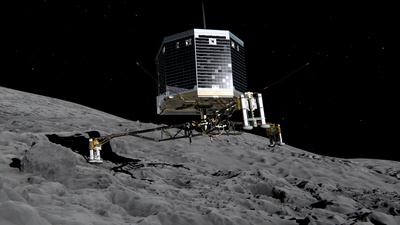Philae Lands on Its Comet — Three Times!
It's been a historic day in planetary exploration. At 15:33 Universal Time, the European Space Agency's Philae spacecraft reached the surface of Comet 67P/Churyumov-Gerasimenko. When radio confirmation reached Earth some 30 minutes later, cheers erupted around ESA's control room in Darmstadt, Germany. (You can replay ESA's landing webcast here.) Never before had a spacecraft landed on a comet.
But Philae's descent wasn't over. The comet has such weak gravity, roughly 1⁄10,000 that on Earth, that its escape velocity is only about 1 mile per hour (0.5 m per second). Philae landed about twice as fast, and bouncing around was a real concern. Telemetry soon showed that a pair of harpoons, designed to anchor the lander immediately after touchdown, didn't deploy as planned. And a small thruster, whose only job was to provide a gentle downward force to keep the lander grounded, didn't fire.
No one realized it at the time, but data from the probe and particularly magnetic-field measurements from its ROMAP instrument later showed that Philae did indeed bounce after touchdown — not once but twice!
The first rebound lasted some two hours, during which the probe spun slowly and drifted upward perhaps 1 km before coming down at 17:26 UT. The second bounce was briefer, ending at 17:33. So Philae actually landed on the comet three times before finally settling down. These unexpected encores explain why radio contact with the lander became intermittent, and why power from Philae's solar-cell arrays fluctuated for a while.
Putting Philae to Work
The day began with Rosetta, the mission's "mother ship," maneuvering into position for the probe's release. Separation followed at 8:35 UT, and Philae began a 7-hour-long free fall toward its carefully selected landing site. (Initially designated simply "J," one among many candidates, the final site was christened Agilkia, for a small island in the Nile River.
Rosetta's camera captured the probe as it slowly drifted away. Philae also took images of the comet during the long descent, including one made public taken from an altitude of about 2 miles (3 km). The initial touchdown, at an estimated speed of just 2 miles per hour (1 meter per second), was unexpectedly soft — the craft's three shock-absorbing legs flexed only about 1½ inches (4 cm).
As of late this afternoon, the washing-machine-size lander appears to have escaped damage. "We still do not fully understand what has happened," admitted Stephan Ulamec, lander manager at the DLR German Aerospace Center, during a post-landing briefing. But Philae's scientific payload was operating as planned, he says. "We have plenty of data."
All this drama played out with the comet some 300 million miles (500 million km) from Earth. That's too far for Philae to communicate directly, so transmissions were relayed by Rosetta. Contact with the lander broke off soon after the lander finally settled down as Rosetta slipped below the horizon. But experiments continued working and storing data according to a preprogrammed sequence. An on-board battery will provide power only for about 64 hours of operation. After that, the 10 instruments aboard will draw electricity from a smaller, secondary battery that, with luck, will be recharged by solar cells mounted on Philae's exterior.
A fuller picture of what happened during the landing should emerge on Thursday, once the orbiter-lander radio link is reestablished. That's also when ESA should also release the first images taken from the comet's surface — and perhaps images of the landing site taken from above by Rosetta.
Coincidentally, Philae's landing took place during the midst of the annual meeting of the AAS's Division for Planetary Sciences. Attendees took time out from the normal proceedings to watch the dramatic landing unfold. Interestingly, another big-time space event — the deliberate crashing of NASA's LCROSS spacecraft and its Centaur rocket into the Moon — coincided with the DPS meeting in 2009.
